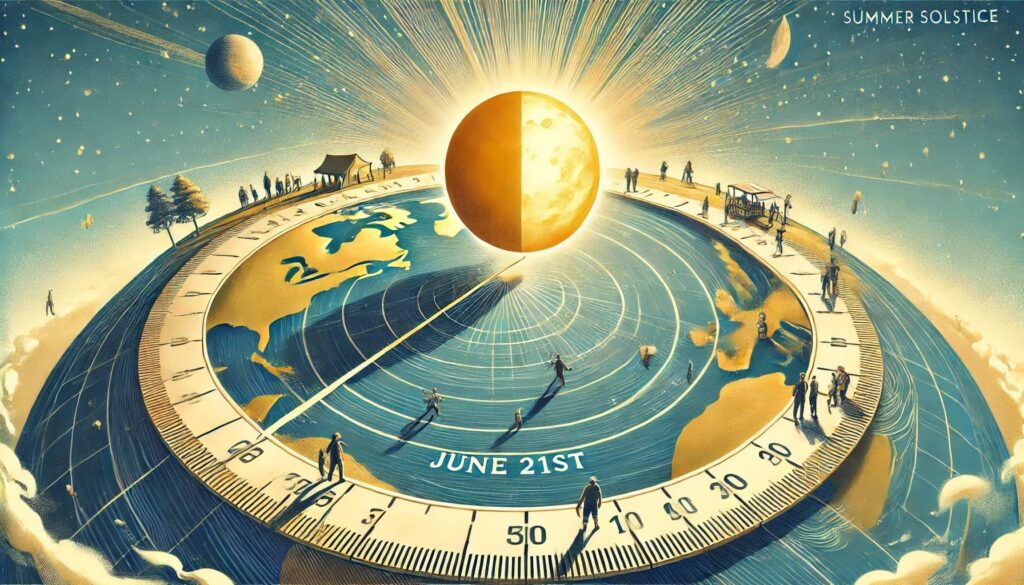The summer solstice is coming, promising longer days and, yes, even hotter temperatures! But before you rush to the air conditioner, let’s explore some fun facts about this annual astronomical phenomenon and find out if we’re really going to melt. Check it out!
What is the Summer Solstice?
The summer solstice is the astronomical event that marks the official start of summer in the northern hemisphere. This year, it will occur on June 20, 2024.
On this day, the North Pole is tilted directly towards the sun, resulting in the longest day of the year. It’s when the sun reaches its highest position in the sky at noon, making the shadows the shortest.

This means more time to enjoy the sun, but also more heat!
Besides being a calendar milestone, the summer solstice has been celebrated by various cultures throughout history. The ancient Druids celebrated at Stonehenge, while in Brazil we have the June festivals.
And who doesn’t love a good outdoor party with bonfires and typical foods? So, get ready to celebrate in style!
Why Celebrate?
Historically, the summer solstice has always been an important event in various cultures around the world.
From the ancient Druids celebrating at Stonehenge to the São João festivals in Brazil, this day is full of traditions and rituals that celebrate light and life.
And who doesn’t love a good outdoor party with bonfires and typical foods?
Interestingly, many of these celebrations have deep roots in how our ancestors viewed the world. They believed the solstice marked a turning point in the annual cycle, bringing renewed energies and times of abundance.
So, take the opportunity to recharge your energies and connect with these ancient traditions!
Is It Going to Get Hotter?
Yes, you can expect an increase in temperatures after the summer solstice. But why does this happen?
Although the solstice marks the longest day, the hottest temperatures usually occur in July and August. This happens because the Earth and its oceans continue to absorb and retain heat, a phenomenon known as the “seasonal lag”.

According to experts, the summer of 2024 promises to be especially hot due to climate change.
So, get ready to face heat waves and make sure to take precautions to stay cool and hydrated. After all, no one wants to melt before the end of summer, right? .
Solar Fun Facts
- The Sun Never Sets… Almost: In areas near the Arctic Circle, like Norway, the summer solstice brings the phenomenon of the “midnight sun,” where the sun never fully sets. Imagine being able to enjoy the sun 24 hours a day!
- Stonehenge and the Sun: Many people gather at Stonehenge in England to see the sunrise aligned with the ancient stones – a magical and historical experience!
- Myths and Legends: In ancient times, it was believed that herbs gathered during the solstice had special powers. So, if you need a lucky charm, this is the time!
- June Festivals: In Brazil, June festivals are celebrated with dances, bonfires, and typical foods, marking this time of abundance and joy.
Scientific Insights: The Sun’s Path
The sun’s path across the sky varies throughout the year due to the tilt of the Earth’s axis. During the summer solstice, the sun takes its longest path, rising at its most northeasterly point and setting at its most northwesterly point.

This results in the longest day and shortest night of the year. Understanding this solar movement helps explain why we experience different seasons and varying lengths of days and nights.
Additionally, the precise tracking of the sun’s movement has been crucial for many ancient cultures in agriculture and timekeeping.
They built structures like Stonehenge and Chichen Itza that align with solstice sunrises and sunsets, showcasing their advanced understanding of astronomy.
Today, we continue to use this knowledge in various scientific and practical applications, from navigation to renewable energy optimization.
Tips to Survive the Heat
- Hydration is Key: Drink plenty of water. Ice cream and popsicles are also welcome!
- Light Clothing: Wear light, light-colored clothing to reflect sunlight.
- Sun Protection: Don’t forget sunscreen and a hat to avoid sunburn.
- Smart Timing: Avoid direct sun exposure between 10 AM and 4 PM, when it’s strongest.
And Now?
Now that you know all about the summer solstice, you’re ready to enjoy the long, hot days in a safe and fun way. So, get ready for an unforgettable summer full of solar adventures!
References
- Scherrer, P., & Scherrer, D. (Year). Solstice and Equinox (“Suntrack”) Season Model. Stanford Solar Center. Available at (standford.edu).
- Al Jazeera. (2024, June 20). Summer solstice 2024: Is it going to get even hotter now? Available at (aljazeera.com).








